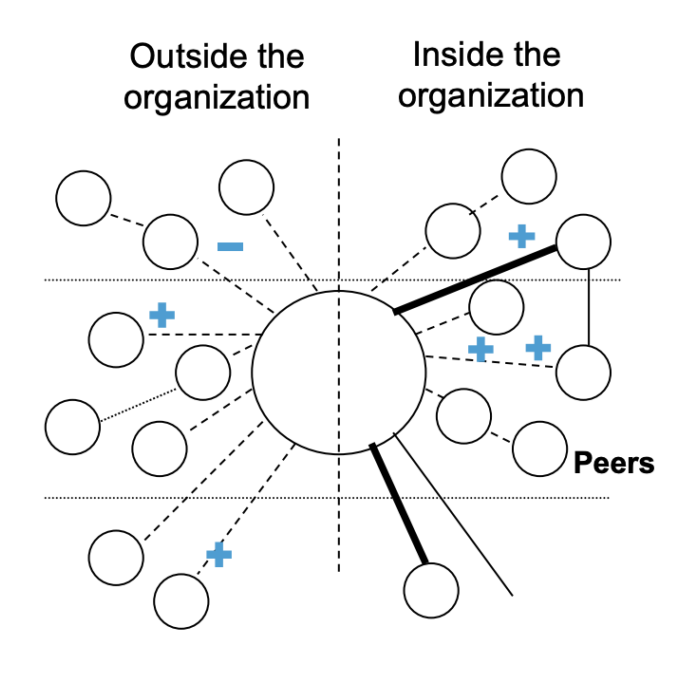08 Apr

As a professional in client service and business development, the term “use your network” is a daily mantra. Establishing relationships strong enough to earn someone’s business and/or trust takes work. Still, understanding your network’s strengths and weaknesses is an exercise few do on a regular basis.
Why is it important to build strong connections?
I understand, the thought of analyzing your network might seem pointless. You know who you know. You work with who you work with. But your network is a gateway to better understanding the people around you, the (professional) currency you trade with, and how to use relationships to accomplish more. Your network can be comprised of client relationships, former colleagues, current colleagues, and more.
💡 Grab a piece of paper, a pencil, and let’s use your network to improve your network and relationship building skills.
Sketching out your network
- Using a simple piece of paper, draw a line down the middle and then two perpendicular lines creating six separate areas
- Label the left side “Outside the Organization” for contacts outside your company who have an impact on your role
- Label the right side “Inside the Organization” for coworkers who have an impact on your role
- In the middle, draw a circle which represents yourself
- Now, draw in bubbles which identify specific individuals in your network:
- Use solid lines to identify direct reports and your manager
- Use dotted lines to identify coworkers above, at, and/or below you
Once complete, it will look something like this:
Who should I add to my network sketch?
Your network has a lot of people. For this networking analysis, focus on those relationships and contacts who match with the following questions:
- Whose cooperation do you need?
- Whose compliance do you need?
- Whose opposition would keep you from accomplishing your work?
- Who are your potential allies?
Define your network relationships
Now that you have sketched out your network and identified various points of contact that impact your work, it is time to define those relationships as good, neutral, or poor.
Next to your network contact bubbles, use a plus-sign or minus-sign as a rating system. This rating system should be based on the mutual trust and credibility of the relationship: + Good | 0 Neutral | – Poor
Focus on your negative and neutral relationships
As you face a visualized version of your network, don’t focus too much on your good and excellent relationships. Those are strong, you’ve done the work. Dive deeper into your neutral and negative relationships.
Pick one or two relationships/people who you’ve identified as either neutral or poor. Take a few minutes and write out what you know to be their:
- Goals
- Values
- Stakes/pressures
- Styles
- Sources of power relative to you
Once you’ve put yourself in their shoes and better understand their point of view, work on improving the network relationship. Take stock of the currency and value you can provide that person. Currency can be defined as:
- Your resources:
- Time
- Team
- Tools
- Information
- Money
- Your skills/expertise
- Anything else you offer
Now, you’ve identified your contact’s motivations, values, and needs; what can you use to help them and at the same time work to transform your relationship from poor-to-neutral or neutral-to-positive?
Review your resources, skills, and expertise, then strategize the best approach to engage that contact and execute your plan. Rinse and repeat. Rinse and repeat.
Networking with just a pencil and paper
Building and improving your network is an exercise of precision and discipline. Utilizing this simple networking analysis can help you:
- Be strategic about relationships
- Keep your network select but diverse
- Back away from redundant, energy-draining connections
- Fill holes with the kind of people
- Get to know people better
- Develop high-quality, reciprocal relationships
- Make the most of your contacts
Start with one contact and track your improvement. If you’re seeing it work, try another contact and then another.
If you liked what you read, we encourage you to sign up for the Seer newsletter for more insights and analyses to better yourself and your business.
Sign up for our newsletter for more posts like this in your inbox:
Source: www.seerinteractive.com, originally published on 2022-04-07 14:01:48
Connect with B2 Web Studios
Get B2 news, tips and the latest trends on web, mobile and digital marketing
- Appleton/Green Bay (HQ): (920) 358-0305
- Las Vegas, NV (Satellite): (702) 659-7809
- Email Us: [email protected]

© Copyright 2002 – 2022 B2 Web Studios, a division of B2 Computing LLC. All rights reserved. All logos trademarks of their respective owners. Privacy Policy



![How to Successfully Use Social Media: A Small Business Guide for Beginners [Infographic]](https://b2webstudios.com/storage/2023/02/How-to-Successfully-Use-Social-Media-A-Small-Business-Guide-85x70.jpg)



![How to Successfully Use Social Media: A Small Business Guide for Beginners [Infographic]](https://b2webstudios.com/storage/2023/02/How-to-Successfully-Use-Social-Media-A-Small-Business-Guide-300x169.jpg)


Recent Comments